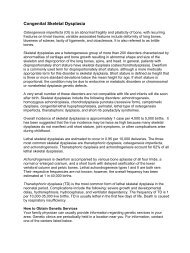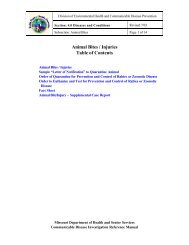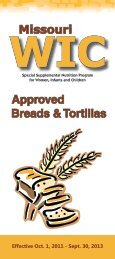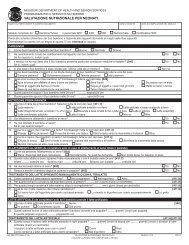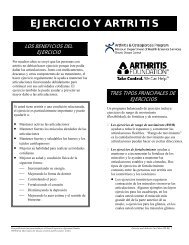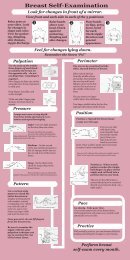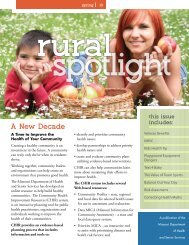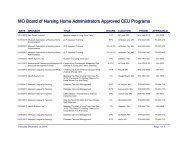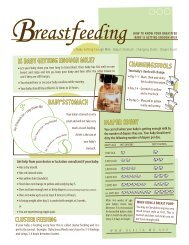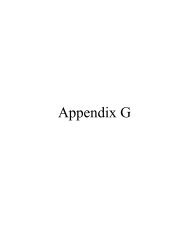category 4 a - oasis data set forms - Missouri Department of Health ...
category 4 a - oasis data set forms - Missouri Department of Health ...
category 4 a - oasis data set forms - Missouri Department of Health ...
Create successful ePaper yourself
Turn your PDF publications into a flip-book with our unique Google optimized e-Paper software.
1. If the wound can be visualized, it is observable. Only surgical wounds that have a<br />
dressing that cannot be removed by physician order and obscures visualization <strong>of</strong> the<br />
incision are considered non-observable.<br />
2. For the purposes <strong>of</strong> determining the healing status, a surgical wound can be<br />
considered fully healed and not reportable as a current surgical wound 4 weeks after<br />
complete epithelialization. The incision must be clean, dry and completely closed with no<br />
signs or symptoms <strong>of</strong> infection. The resulting scar would only be reported as a<br />
wound/lesion (M1350) if it received clinical intervention by the home health agency and<br />
was not reported in one <strong>of</strong> the prior OASIS wound items.<br />
3. The status <strong>of</strong> the most problematic (observable) surgical wound (M1342) is<br />
determined by assessment <strong>of</strong> the skilled clinician following the WOCN OASIS Wound<br />
Item Guidance.<br />
M1350: If the wound that is cemented meets the OASIS criteria to be a skin lesion or<br />
open wound for M1350, (a lesion or open wound excluding bowel ostomies, other than<br />
those described in prior OASIS wound items, that is receiving clinical intervention by the<br />
home health agency), then it would be considered a skin lesion or open wound for<br />
M1350. If the OASIS criteria excluded the wound type from being reported in M1350<br />
(i.e., bowel ostomy), then the wound would not be reported on M1350, regardless <strong>of</strong> the<br />
type <strong>of</strong> closure utilized.<br />
Q112. [Q&A RETIRED 09/09; Duplicative <strong>of</strong> OASIS-C Guidance Manual]<br />
Q112.1. [Q&A RETIRED 09/09; Outdated]<br />
Q112.2. [Q&A RETIRED 09/09; Outdated]<br />
Q112.3. [Q&A RETIRED 09/09; Outdated]<br />
[Q&A ADDED 09/09; Previously CMS OCCB 07/08 Q&A #9]<br />
Q112.4. M1342. If staples remain in a surgical wound, would it be considered as<br />
not healing?<br />
A112.4. A surgical wound with staples in place would only be considered not healing<br />
if it meets the WOCN Guidance on OASIS Skin and Wound Status M0 Items’ definition<br />
<strong>of</strong> not healing. The WOCN guidance can be found at www.wocn.org. Presences <strong>of</strong><br />
staples, in and <strong>of</strong> themselves, do not meet the WOCN criteria for non-healing.<br />
Q&A ADDED & EDITED 09/09; Previously CMS OCCB 07/08 Q&A #12]<br />
Q112.5. M1342. Does the presence <strong>of</strong> a "scab" indicate a non-healing wound?<br />
A112.5. [Q&A ADDED 09/09; Previously CMS OCCB 07/08 Q&A #12]<br />
A scab is a crust <strong>of</strong> dried blood and serum and should not be equated to either<br />
avascular or necrotic tissue when applying the WOCN guidelines. Therefore while the<br />
presence <strong>of</strong> a scab does indicate that full epithelialization has not occurred in the<br />
scabbed area, the presence <strong>of</strong> a scab does not meet the WOCN criteria for reporting the<br />
wound status as “not healing”.<br />
This represents a retraction <strong>of</strong> previous guidance that indicated a scab was considered<br />
avascular or necrotic tissue, and therefore an indicator <strong>of</strong> a non-healing surgical wound.<br />
(Note: This new CMS guidance will supersede prior archived guidance found in CMS<br />
OASIS Q&As; Category 4, Questions 112.1, 112.2, and 112.3)<br />
Category 4 – OASIS Data Set – Forms and Items 09/09



